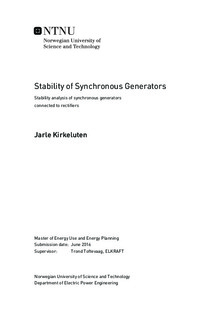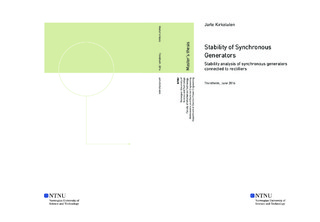| dc.description.abstract | This master s thesis constitutes a continuation of a master s thesis (2015) and two specialization projects (2014, 2015) at NTNU. The basis for the work presented in this thesis is an islanded power system onboard a tug-boat. This is a power system where the load is supplied through a rectifier / inverter. This design is used in order to allow the diesel engine in the system operate at an optimum speed at any given time. The power system is experienced to be unstable during normal operation. The instability is reflected in oscillations in the output power, voltages and speed. The cause of the instability is not yet found and the literature regarding these kinds of problems does not yield any defined answers to why instability occurs in such systems.
The thesis presents two models, one in PSCAD and one in DigSILENT Powerfactory. Both models are able to recreate the instability problem. Based on literature and previous work, it is believed that the oscillations can be related to a poorly damped synchronous generator. Investigation of the inertia constant of the synchronous generator supports this theory. It is further tried to enhance the damping by installing an additional damper winding on the rotor which also yields a positive result. Based on these findings is it plausible to connect the cause of the instability problem to the synchronous generator and its poorly damping.
The constant switching caused by the diode rectifier in the system is observed to be a factor that might contribute to amplify the instability problem. The synchronous generator is operating in the transient state due to these small disturbances by the rectifier. This theory is also supported by literature found about the problem. It was tested to change the rectifier from a diode rectifier to a thyristor rectifier, this was found to not enhance the stability of the system. By reducing the DC voltage at the DC terminal of the thyristor rectifier in addition to reduce the gain of the AVR is it possible to make the system stable.
A PSS is also introduced to the system in an attempt to provide an additional damping torque to the synchronous generator during this transient state of operation. The result of these simulations has not provided any satisfactory result. Whether this is because of poorly chosen parameters of the PSS or because of other factors is not known. The time did not allow for any further investigation of this solution. | |

